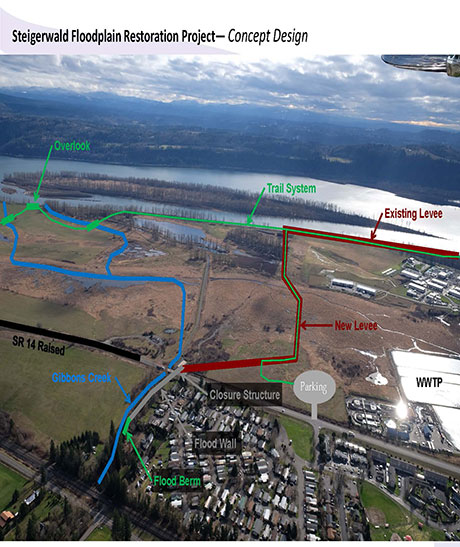The Bonneville Power Administration, with several federal, state and local partners, is embarking on a project that will reconnect vital floodplain habitat to the Columbia River. The Steigerwald Floodplain Restoration Project is the largest estuary restoration project BPA has sponsored.
Biologists say once it’s restored, the floodplain will be a prime juvenile fish “nursery,” BPA said in the press release.
“Juvenile salmon migrating through the Columbia River Basin on their way to the Pacific Ocean need areas where they can rest and grow while transitioning from fresh water to salt water,” said Jason Karnezis, BPA Estuary Program Lead. “When the Steigerwald Floodplain Restoration Project is complete, salmonids will have access to 960 acres of floodplain that is currently inaccessible.”
The Steigerwald Lake National Wildlife Refuge sits next to the Columbia River, just upstream from the Port of Camas-Washougal in Washington. The project’s goals are consistent with meeting the mitigation requirements of the Northwest Power Act and current Endangered Species Act regulations, said BPA, and will involve:
•Excavating and reshaping approximately 3 miles of tidally-influenced channels, allowing fish passage for returning adults to Gibbons Creek, a tributary running through the refuge.
•Modifying the existing levee system to reconnect water channels to the mainstem Columbia.
•Rebuilding the existing trail system and adding bridges that will allow unimpeded access for fish in the channels.
•Relocating the existing parking lot and visitor area from the floodplain to behind the new setback levee to provide buffers for the restored Gibbons Creek.
•Raising State Route 14 to the Columbia River’s 500-year flood elevation.
The restoration is due to be complete in 2022.
BPA is working with the Lower Columbia Estuary Partnership, the U.S. Fish and Wildlife Service, Port of Camas-Washougal, and other public and private partners. The restoration design is complex and required several project permits, among them a permit from the U.S. Army Corps of Engineers allowing modifications to the existing levee system.
According to Debrah Marriott, Estuary Partnership Executive Director, those challenges make reaching the goal even sweeter. She said it’s a project that will benefit the region for decades to come.
“The Steigerwald project meets so many needs,” said Marriott. “We’re restoring nearly 1,000 acres of habitat for migrating fish, removing private and public property from the flood zone, improving recreation opportunities and creating local jobs.”
The 1,049-acre wildlife refuge is unique in that it is located within the Portland/Vancouver metro area and straddles both rural and industrial environments: to the east is a private ranch; to the west, the Washougal Wastewater Treatment Plant that serves about 15,000 Washougal residents and businesses; and an industrial area that is home to many businesses, including manufacturers, food processors and a restaurant.
Steigerwald is one of 568 refuges in the National Wildlife Refuge System managed by the USFWS. It is part of the larger Ridgefield National Wildlife Refuge Complex.

